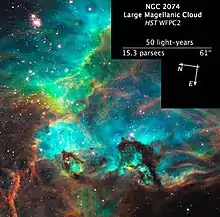NGC 2074
NGC 2074 is a magnitude ~8 emission nebula in the Tarantula Nebula located in the constellation Dorado. It was discovered on 3 August 1826 by James Dunlop and around 1835 by John Herschel. It is described as being "pretty bright, pretty large, much extended, [and having] 5 stars involved".[3]
| Emission nebula | |
|---|---|
 | |
| Observation data: J2000 epoch | |
| Right ascension | 05h 39m 03.0s[3] |
| Declination | −69° 29′ 54″[3] |
| Distance | 170,000 ly (52,000 pc) |
| Constellation | Dorado[1] |
| Designations | GC 1272, JH 2942 |
Discovery
Some of the objects catalogued by Herschel before 1847 do not have a discovery date listed, and NGC 2074 is one of them. Though its inclusion in the catalog of objects observed in the Large Magellanic Cloud which involves observations carried out between 2 November 1836 and 26 March 1837 shows it must not have been discovered later than that.[3]
The observation of NGC 2074 by Dunlop was not identified as this object until recently.[3]
Location
NGC 2074 is located around 170,000 light-years (1.1×1010 AU) away. The area has a lot of raw stellar creation, possibly triggered by a nearby supernova explosion and is on the edge of a dark molecular cloud which is an incubator for the birth of new stars.[2]
References
- "Hubble Unveils Colorful and Turbulent Star-Birth Region on 100,000th Orbit Milestone". Hubblesite.org. 11 August 2008. Archived from the original on 4 March 2016.
- "Hubble unveils image of NGC 2074". Astronomy.com. 11 August 2008. Retrieved 14 January 2019.
- Seligman, Courtney. "Celestial Atlas: NGC Objects: NGC 2050 - 2099". CSeligman.com. Retrieved 14 January 2019.
